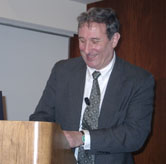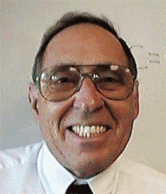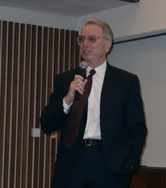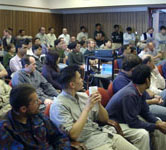Inaugural Shannon Memorial Lecture
|
5.9.03 - On May 5, a standing-room-only audience including QUALCOMM founder Irwin Jacobs was on hand as UCSD launched a new lecture series about information theory and its applications ranging for the biological sciences to electronics. The Shannon Memorial Lecture is named for Claude E. Shannon, the father of information theory, and the annual lectureship was conceived, organized, and funded by Jack Wolf, the Steven O. Rice Professor in UCSD's Center for Magnetic Recording Research (CMRR). The committee established to select the annual lecturer is led by Richard Attiyeh, UCSD's Vice Chancellor of Research, and co-chaired by QUALCOMM co-founder Andrew Viterbi and CMRR director Paul Siegel. The inaugural-event turnout was in large part due to the stature of the principal speaker and his topic. Cornell University's Toby Berger spoke on "Information Theory and Real Neural Nets." By 'real,' Berger explained, his focus was on sensory signal processing in living beings, especially humans. "It boils down to neurons and the connections among them," said Berger. "Everything you see, hear, feel, every movement, all of your thoughts, even emotions and personality, can be explained ultimately in terms of patterns of activity in networks of neurons." Berger is the Irwin and Joan Jacobs Professor of Engineering in the School of Electrical and Computer Engineering at Cornell University [Irwin Jacobs' alma mater]. "It's good to have a chance to get back at Toby," Jacobs said in introducing him. "One time when I spoke at Cornell, he had to introduce me, and managed to locate my original application from high school to Cornell, and he reminded the audience that I started at the hotel school, not engineering!" [Berger's wife Florence, who was in the audience, is a professor at Cornell's School of Hotel Administration.] Jacobs credited Claude Shannon with influencing his decision to go into communications theory and, ultimately, the code division multiple access wireless technology on which QUALCOMM is based. In opening the session, UCSD's Wolf thanked both CMRR and the California Institute for Telecommunications and Information Technology [Calit²] for co-sponsoring the event, including a live webcast on the Internet. The proceedings are now archived for on-demand viewing at http://earth.ucsd.edu:8080/ramgen/calit2/tobyberger.smi [RealPlayer required]. According to Berger, neural signaling in the human brain can be modeled as a time-discrete binary random field. "The brain delivers some 1015 binary digits (to their destinations) several hundred times per second," he explained. "Although the Internet perhaps also moves several hundred petabits during one second, it has many relay nodes and therefore may deliver less information per second to its destination than does a single brain. Certainly, the Internet does not compute and transmit to all intended destinations a new petabit 2.5 milliseconds later that depends intimately on the values assumed by the previous one. Since the computing power and especially the communicating power of an individual neuron are relatively weak compared to those of modern electronic computer logic elements, we reach the inescapable conclusion that the brain's celebrated computing prowess must stem in considerable measure from its topological connectivity." In his lecture, Berger discussed how to model neural regions responsible for sensory perception as time-discrete, finite-memory channels with feedback. The input and output spaces of these regions are binary vectors that possess millions of components. The channel's latest output vector, which serves also as the channel state, gets fed back to the channel input. Berger says his research shows that energy efficient information transmission across such neural regions necessarily results in an output process that is first-order Markovian, though not necessarily homogeneous. Likewise, the joint (input, output) is first-order Markov, though the input process is not necessarily Markov. "How the brain goes about assuring that the sensory information that gets conveyed within and among its application-specific neural regions is the information that is most pertinent to the tasks that need to be addressed is only vaguely understood at present," said Berger. "We suggest an approach to energy-efficient joint source-channel neural coding of sensory information based on extensions of concepts from multiterminal information theory coupled with ideas from recursive estimation theory." Related Links Toby Berger http://people.ece.cornell.edu/berger/ "Claude Shannon: Father of the Information Age" [Video] http://webcast.ucsd.edu:8080/ramgen/ Shannon Symposium [October 2001] http://www.calit2.net/events/2001/shannon_01.html CMRR http://cmrr.ucsd.edu/homeset.htm Calit² http://www.calit2.net |
|




